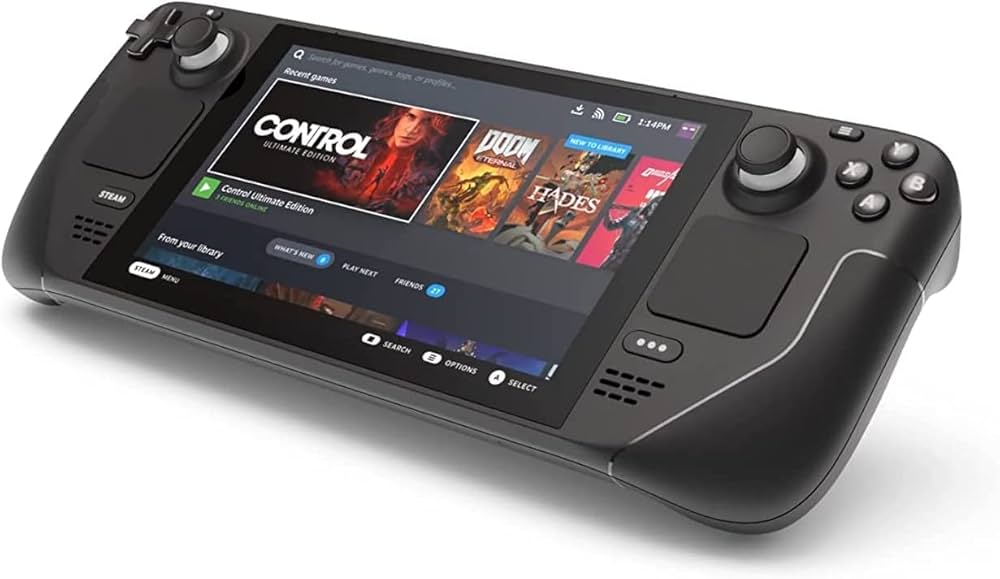Steam Deck: A Comprehensive Product Overview
The Steam Deck is a handheld gaming computer developed by Valve Corporation, designed to bring powerful, portable PC gaming with a console-like user experience. It allows users to bring their Steam game library with them wherever they go, embodying the concept of “Your games, everywhere”.
Core Design and Operating System The Steam Deck integrates a custom AMD APU and runs on SteamOS, a Linux-based operating system. Building on Valve’s prior work with Steam Machines and the Steam Controller, the Steam Deck represents a shift towards in-house hardware development for Valve. While SteamOS was initially based on Debian Linux for Steam Machines, Valve chose Arch Linux for the Steam Deck to facilitate a rolling upgrade approach for the system software. A key feature of SteamOS is its support for Proton, a compatibility layer that enables games developed for Windows to run on the Linux-based SteamOS without modification. Additionally, the Steam Deck includes a desktop mode (using KDE Plasma) and allows users to install third-party Linux applications or even entirely different operating systems.

Steam Deck
OLED
1TB SSD

Steam Deck
LCD
1TB

Steam Deck
LCD
512GB
Models and Specifications The Steam Deck has been released in several models since its initial launch in February 2022, with newer OLED versions introduced in November 2023.
Original LCD Models (Released February 2022):
- 256GB NVMe SSD. This model is now the new base model, as the 64GB eMMC and 512GB NVMe LCD models have been discontinued.
- 1280 x 800 optically bonded LCD display with a 7″ diagonal size.
- Up to 60Hz refresh rate.
- 7 nm APU (named Aerith, based on Zen 2 and RDNA 2 architectures).
- Wi-Fi 5 and Bluetooth 5.0.
- 40Whr battery, offering 2-8 hours of gameplay (content dependent). For intensive games like Portal 2, it can play for 5-6 hours when frame rates are kept around 30 FPS.
- 45W power supply with a 1.5m cable.
- Includes a carrying case and a Steam profile bundle.
Newer OLED Models (Released November 2023): These models replace the previous top-tier LCD variants. - 512GB NVMe SSD.
- 1TB NVMe SSD.
- 1280 x 800 HDR OLED display with a larger 7.4″ diagonal size. The OLED screen was a desired feature for the original launch but was not available in sufficient size and quality at the time.
- Up to 90Hz refresh rate.
- 6 nm APU (a revised processor named Sephiroth).
- Wi-Fi 6E and Bluetooth 5.3 support.
- 50Whr battery, providing 3-12 hours of gameplay (content dependent) and an estimated 25% improvement in capacity.
- 45W power supply with a longer 2.5m cable.
- Both OLED models come with a carrying case. The 1TB model includes a premium anti-glare etched glass, a carrying case with a removable liner, an exclusive startup movie, and an exclusive virtual keyboard theme.
- These models also feature improved cooling.
All Steam Deck models feature 16 GB of LPDDR5 RAM. Input methods include two clickable analog sticks with capacitive touch, two pressure-sensitive touchpads, a D-pad, ABXY buttons, shoulder buttons, four grip buttons on the rear, and various system buttons. It also incorporates a 6-axis IMU (gyroscope and accelerometer), microphone, and ambient light sensor.
Ergonomics and User Experience Valve has been praised for “nailing the ergonomics” of the Steam Deck, making it comfortable for extended play sessions without discomfort. The device’s size is considered “perfect” by many users, allowing for hours of gameplay without pain. A standout feature is the inclusion of touchpads, which are highly valued for navigating desktop mode, web browsing, and controlling cursor-based games such as card games, strategy games, and point-and-click titles, offering a level of precision not easily achievable with thumbsticks. The capacitive thumbsticks, particularly when combined with gyro controls, allow for intuitive gyro ratcheting, enhancing aiming and camera control. The four rear grip buttons are also considered indispensable by many users once accustomed to them.
The Steam Deck’s software is designed for ease of use. The Steam client on the Deck features a revised interface, consistent with the desktop version but optimized for controller input. It supports all standard Steam functions, including user profiles, friends lists, game communities, cloud saving (including Dynamic Cloud Sync for portable use), Steam Workshop, and Remote Play. For games not utilizing the Steam Deck API, the handheld automatically translates controller input.
Performance and Game Compatibility While its specifications are considered modest compared to high-end gaming PCs, the Steam Deck is capable of running most games in the Steam catalog. Valve has stated that the Steam Deck can handle any game, including AAA titles, without falling below a minimum 30 frames-per-second performance. Users report playing demanding games like Cyberpunk 2077, Red Dead Redemption 2, and Kingdom Come: Deliverance II effectively. Some users even report playing Diablo 4 at high settings with 60 FPS. However, demanding new AAA titles may require sacrificing graphical settings to achieve playable performance.
Game compatibility is managed through Valve’s “Deck Verified” system, categorizing games as “Verified,” “Playable,” or “Unsupported”. “Verified” games are fully compatible out-of-the-box, “Playable” games may require minor user adjustments, and “Unsupported” games are not fully compatible (e.g., VR games, or those with Windows-specific codecs). A significant challenge remains with anti-cheat systems (like those in Battlefield 1, Helldivers 2, Hunt Showdown, Destiny 2, or Fortnite) that may prevent multiplayer or live-service games from running on SteamOS. Despite this, Valve has worked with anti-cheat providers like Easy Anti-Cheat and BattlEye to improve compatibility with Proton. While some critics point to a lower percentage of “Verified” and “Playable” titles among the top 1000 Steam games, others highlight the tens of thousands of compatible titles in the Steam Deck’s library.
Beyond Steam, the open nature of the Steam Deck allows for the installation of third-party game launchers (like Epic Games Store, Ubisoft Connect, or Origin) and even emulators. Microsoft Edge can be used for Xbox Cloud Gaming, providing access to that game catalog for Game Pass subscribers.
Docking and Connectivity An optional dock unit, released in October 2022, expands the Steam Deck’s connectivity. The dock allows connection to an external power source, an external monitor (via HDMI or DisplayPort, supporting resolutions up to 8K at 60Hz or 4K at 120Hz), Ethernet, and USB devices. There is no change in performance when the Steam Deck is docked compared to handheld mode. The dock also supports variable refresh rate monitors with SteamOS update 3.5.5. The Steam Deck is compatible with any third-party docking station offering similar interfacing.
Reception and Market Impact The Steam Deck has received largely positive reception since its announcement, with industry figures from Epic Games and Xbox Game Studios praising Valve’s initiative. It has been frequently compared to the Nintendo Switch, though Valve emphasized that the Deck was not designed to compete directly with the Switch but rather to target a different audience of PC gamers. Reviewers noted the Steam Deck’s greater power compared to the Switch, but often at the cost of battery life for the original LCD model.
One of the main criticisms of the initial Steam Deck models was its battery life, with some graphically demanding games draining a full charge in as little as two hours. However, the OLED models addressed this concern with larger batteries and improved efficiency.
Commercially, the Steam Deck has achieved notable success, selling “multiple millions” of units by November 2023. Research firms estimated sales surpassing 3 million units in 2023, and between 3.7 and 4 million by February 2025. The Steam Deck is widely credited with triggering a wave of similar handheld gaming computers from other manufacturers, such as the Asus ROG Ally, Lenovo Legion Go, and MSI Claw A1M.
Future Outlook Valve is actively pursuing improvements for the Steam Deck, including per-game power profiles and other performance enhancements. While the company has no immediate plans for a successor, they have stated they are working towards a Steam Deck 2 with overall system improvements, including CPU and GPU chips. However, such a device is likely two to three years away, as Valve aims to wait for a “generational leap” in CPUs that offers significantly better computing power without large increases in power requirements.
